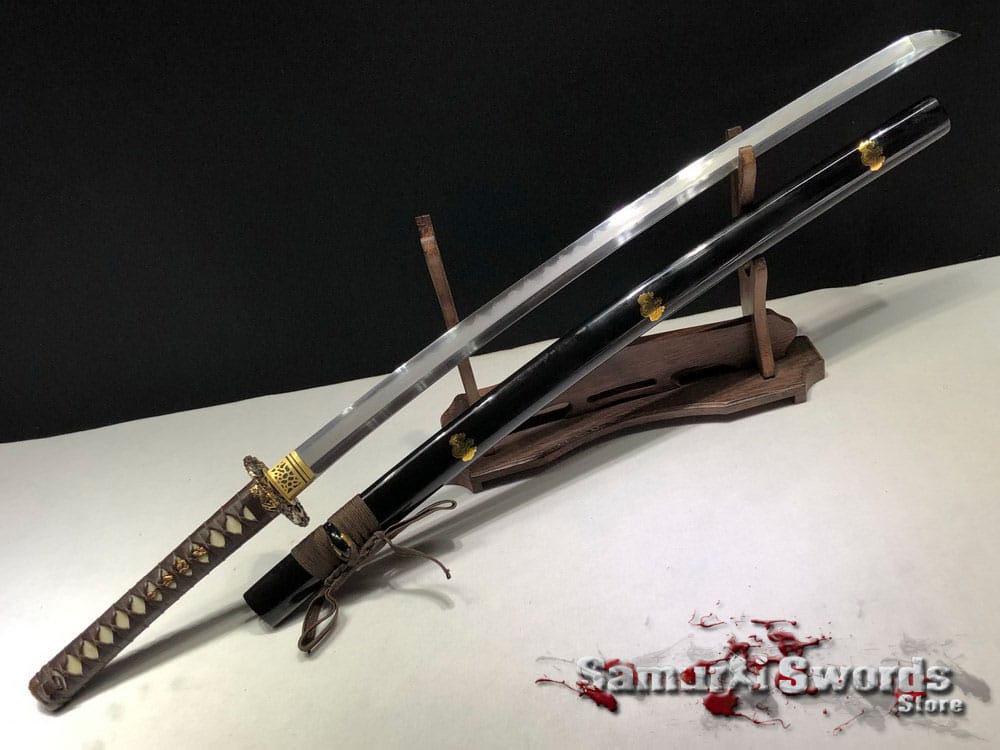Samurai Katana Sword T10 Folded Clay Tempered Steel with Hadori Polish
This Samurai Katana Sword is made of T10 Folded Clay Tempered Steel with Hadori Polish, featuering Golden Crest Saya and High Quality Copper Fittings
Sword Type: Katana
Steel Type: T10 Folded Clay Tempered Steel Hadori Polish
Blade Length: 72 Centimeters
Handle Length: 27 Centimeters
Blade Width: 3.2 Centimeters
Weight: 1.59KG
Tang: Full Tang
Sharpness: Sharpened
Blood Groove: No Bohi (Blood Groove)
Tsuba (Handguard): High Quality Copper Tsuba
Fuchi (Hilt Collar): High Quality Copper Fuchi
Kashira (Pommel): High Quality Copper Kashira
Menuki (Handle Ornaments): High Quality Copper Menuki
Saya (Scabbard): Golden Crest Saya
Ito (Wrap): Authentic Brown Leather
Ray Skin (Samegawa): White
Sword Bag: Silk
This is a Katana that sports a Tsuka wrapped in a white Samegawa. Plus, it comes with an authentic brown leather Ito to further secure the grip. the blade has been crafted from T10 folded, clay tempered steel that has also been Hadori polished.
Product Dimensions and Inclusions
This swords blade has a length of 72 centimeters and a width of 3.2 centimeters. It weighs a total of 1.59 kilograms while the Tsuka measures 27 centimeters long.
The Samurai sword is protected by a Golden crest Saya. It is not only for safeguarding the sword, but also for adding more aesthetics and style to it. In addition, this Katana comes with a silk sword bag for additional protection. You can use this for carrying the sword around when going for practice.
Katana Fittings
All fittings of the Katana are made of HQ copper. The Tsuba It is the guard protecting your hand from the opponent’s blade, while the Kashira is made for balance. It is the pommel at the end of the Katana handle.
The other fitting is the Menuki which are ornamental pieces set beneath the Tsuka Ito. The Fuchi is the handle collar that conceals the opening on the Tsuka. If you want to use different fitting or change anything within the sword, you can customize your Katana here.
The Type of Steel for the Sword
This Katana makes use of T10 Steel that went through folding and Hadori polishing. T10 is a kind of steel that is tough and durable, making it a great material for crafting swords.
Folding was a refinement process for steel in ancient Japan. Today, it is a process that enhances the Katana swords artistic value. The blade is clay tempered. This is a process where a wet mixture of clay is applied to the sword.
The compound often consists of clay, stone powder, water, rust, and a bit of ash. Clay slurry is applied to the blades edge and spine; later, the blade will undergo sharpening.
The Katana Blade
As mentioned, this Katana has a Hadori polished blade. It was a polishing method developed by a famous polisher. It works to enhance the brilliance of the Hamon.
Its blade is fully sharpened, and whats most important is that its a full tang. This means that it’s Tang stretches out to the entire length of the Tsuka.
Having a full tang sword makes the blade and handle one solid piece, leaving this Katana more durable and resistant to rough and rigid use.
Tsuka Ito and Samegawa
The combination of authentic brown Ito and white Samegawa make for a great-looking Samurai sword. Yet aside from adding its aesthetics, these have other functions too.
The Ito reinforces the Tsuka, preventing issues when using the Katana. Leather is a great material since its durable and has a tight hold.
The Samegawa helps keep the Ito in place and it wont loosen while in use. The Samegawa also enhances better grip, preventing slip ups while your hands are sweating after long use.

